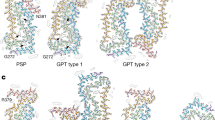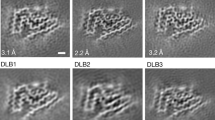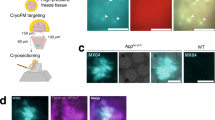Abstract
During ageing of the human brain, and particularly in senile dementia of the Alzheimer type (AD), many neurones progressively accumulate abnormal cytoplasmic fibres, called paired helical filaments (PHF)1–3. Each such fibre consists of a pair of intermediate (10 nm) filaments twisted into a double helix with a periodicity of 160 nm. PHF accumulate in large perikaryal masses, called neurofibrillary tangles, and are also found in degenerating cortical neurites that form neurite plaques. The density of PHF-containing neurites and cell bodies correlates with the degree of dementia4–6 and the extent of loss of cholinergic neurotransmitter function7 in AD. Recently, we demonstrated that PHF from human cerebral cortex are large, rigid polymers with unusual molecular properties, including insolubility in SDS, urea and other denaturing solvents8 and apparent resistance to protease digestion9. These properties have so far prevented complete purification and analysis of the constituents of PHF. Based on their insolubility, we have developed a new method of preparing highly enriched PHF fractions and have raised an antiserum that is highly specific for PHF. We report here that this antiserum specifically labels PHF, free of any associated normal fibrous proteins and, unexpectedly, it reacts with neither neurofilaments nor any other normal cytoskeletal protein in brain sections or on immunoblotted gels. These anti-PHF antibodies have been used for the specific detection of Alzheimer-type PHF and in the search for cross-reacting antigens in various tissues, and are suitable for immunoaffinity purification of PHF. Our results indicate that PHF contain determinants that are not shared with normal neuronal fibrous proteins.
This is a preview of subscription content, access via your institution
Access options
Subscribe to this journal
Receive 51 print issues and online access
$199.00 per year
only $3.90 per issue
Buy this article
- Purchase on Springer Link
- Instant access to full article PDF
Prices may be subject to local taxes which are calculated during checkout
Similar content being viewed by others
References
Kidd, M. Nature 197, 192–194 (1963).
Terry, R. D., Gonatas, N. F. & Weiss, M. Am. J. Path. 44, 269–297 (1964).
Wisniewski, H. M., Narang, H. K. & Terry, R. D. J. neurol. Sci. 27, 173–181 (1976).
Tomlinson, B. E., Blessed, G. & Roth, M. J. neurol. Sci. 11, 205–243 (1970).
Ball, M. J. Acta neuropath. 37, 111–118 (1977).
Tomlinson, B. E. & Henderson, G. in Neurobiology of Aging (eds Terry, R. D. & Gershon, S.) 183–204 (Raven, New York, 1976).
Perry, E. K., Tomlinson, B. E., Bergman, K., Gibson, P. H. & Perry, R. H. Br. med. J. ii, 1457–1459 (1978).
Selkoe, D. J., Ihara, Y. & Salazar, F. J. Science 215, 1243–1245 (1982).
Selkoe, D. J., Abraham, C. & Ihara, Y. Neurology 33, 35 (1983).
Ihara, Y., Nukina, N., Sugita, H. & Toyokura, Y. Proc. Japan. Acad. 57, 152–156 (1981).
Laemmli, U. K. Nature 227, 680–695 (1970).
Towbin, H., Staehelin, T. & Gordon, J. Proc. natn. Acad. Sci. U.S.A. 76, 4350–4354 (1979).
Gambetti, P. et al. in Ageing of the Brain and Dementia (eds Amaducci, L., Davison, A. N. & Antuono, A.) (Raven, New York, 1980).
Dahl, D., Selkoe, D. J., Pero, R. T. & Bignami, A. J. Neurosci. 2, 113–119 (1982).
Anderton, B. H. et al. Nature 298, 84–86 (1982).
Autilio-Gambetti, L., Gambetti, P. & Crane, R. C. in Alzheimer's Disease (ed. Katzman, R.) (Cold Spring Harbor Laboratory, New York, in the press).
Rasool, C. G., Anderton, B. H., Kahn, J., Ihara, Y. & Selkoe, D. J. J. Neuropath. exp. Neurol. 42, 335 (1983).
Gambetti, P., Autilio-Gambetti, L. & Papasozomenos, S. Ch. Science 213, 1521–1522 (1983).
Bradford, M. M. Analyt. Biochem. 72, 248–254 (1976).
Author information
Authors and Affiliations
Rights and permissions
About this article
Cite this article
Ihara, Y., Abraham, C. & Selkoe, D. Antibodies to paired helical filaments in Alzheimer's disease do not recognize normal brain proteins. Nature 304, 727–730 (1983). https://doi.org/10.1038/304727a0
Received:
Accepted:
Published:
Issue Date:
DOI: https://doi.org/10.1038/304727a0
This article is cited by
-
The Ubiquitin-Proteasome System and Molecular Chaperone Deregulation in Alzheimer’s Disease
Molecular Neurobiology (2016)
-
Different immunoreactivities of the microtubule-binding region of tau and its molecular basis in brains from patients with Alzheimer's disease, Pick's disease, progressive supranuclear palsy and corticobasal degeneration
Acta Neuropathologica (2003)
-
Tau as a nucleolar protein in human nonneural cells in vitro and in vivo
Chromosoma (1996)
-
Hereditary cerebral hemorrhage with amyloidosis (Dutch): a model for congophilic plaque formation without neurofibrillary pathology
Acta Neuropathologica (1994)
-
A case of Pick's disease with unusual neuronal inclusions
Acta Neuropathologica (1994)
Comments
By submitting a comment you agree to abide by our Terms and Community Guidelines. If you find something abusive or that does not comply with our terms or guidelines please flag it as inappropriate.



